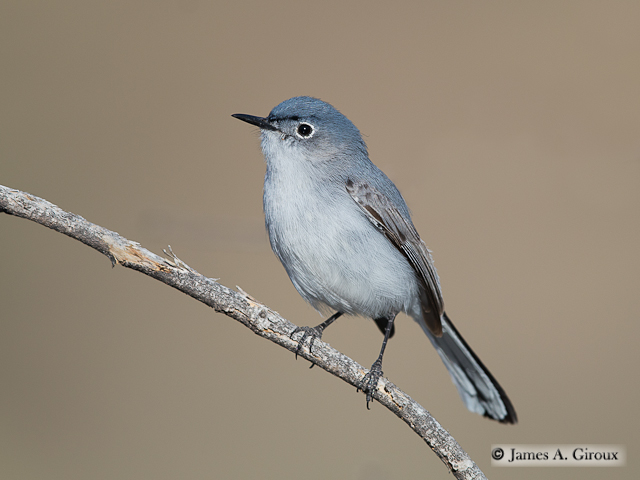Blue-gray Gnatcatcher Polioptila caerulea
 Blue-gray Gnatcatcher breeding male. Photo Credit: James A. Giroux
Blue-gray Gnatcatcher breeding male. Photo Credit: James A. Giroux
Flitting from branch to branch, this petite bird can be challenging to spot as it’s never in one spot for long. At a mere 4 to 5 inches in length, the Blue-gray Gnatcatcher can be distinguished from a distance by its long tail, thin white eye ring, and namesake blue-gray coloring. Breeding males can be identified by a black band spanning from brow to brow. Females and non-breeding males tend to be a duller gray.
 Blue-gray Gnatcatcher female/non-breeding male. Photo Credit: Sharif Uddin
Blue-gray Gnatcatcher female/non-breeding male. Photo Credit: Sharif Uddin
Although the Blue-gray Gnatcatcher primarily feeds on small insects and spiders, gnats are not a significant part of their diet. Their hunting grounds include areas of foliage, such as trees and shrubs, where they flick their tail from side to side as they seek their prey.
The Blue-gray Gnatcatcher builds a tiny nest that often resembles a knot on a branch made of spider web and plant fibers. Pairs can build as many as 7 nests during a single breeding season, with the male assisting in nest building. Despite their small stature, Blue-gray Gnatcatchers are aggressively territorial and have been known to pursue rivals up to 70 feet.

A Blue-gray Gnatcatcher building its nest. Photo Credit: Skip Russell
When seeking the Blue-gray Gnatcatcher, sound is often more key than sight due to their speed. Both males and females use high-pitched, whining calls, sometimes in sharp bursts of brief notes a few seconds at a time. If you have large trees in your backyard (especially oak) or live near a wooded area, drop by to listen for a mewing “spee,” then look up and try not to blink!
Compiled by Lainee Hooks
Sources include: All About Birds (Cornell), Audubon Field Guide, “Reader’s Digest North American Wildlife.” (1982)




